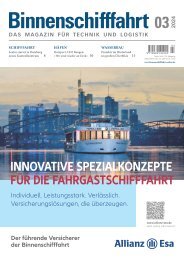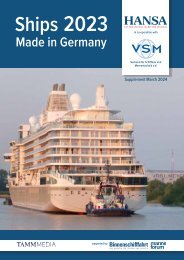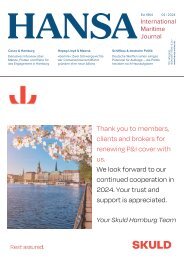HANSA Greek Shipping 2024 Posidonia Edition
SHIPPING: Greece in numbers / Interview Theodore Vokos, Managing Director, Posidonia Exhibitions / Interview Elias Kariambas, Vice President, Regional Business Development, Greece / Interview Michael Suhr, Senior Vice President and Regional Director North Europe at Korean Register (KR) / Greek shipowners on the way to Net Zero / Greek company’s strong in Capesize sector / Personal support as a USP SHIPBUILDING: Welcome to Posidonia 2024 / Setting sail for success in Greek market / Interview Jörg Karthaus, Head of Sales, Pleiger Maschinenbau / A data driven crystal ball / LNG fuelled LCO2 carriers: going for growth / 75 years of MMG Propeller – an eventful success story / Interview Lars Greitsch, CEO at Mecklenburger Metallgus (MMG)
SHIPPING: Greece in numbers / Interview Theodore Vokos, Managing Director, Posidonia Exhibitions / Interview Elias Kariambas, Vice President,
Regional Business Development, Greece / Interview Michael Suhr, Senior Vice President and Regional Director North Europe at Korean Register (KR) / Greek shipowners on the way to Net Zero / Greek company’s strong in Capesize sector / Personal support as a USP
SHIPBUILDING: Welcome to Posidonia 2024 / Setting sail for success in Greek market / Interview Jörg Karthaus, Head of Sales, Pleiger Maschinenbau / A data driven crystal ball / LNG fuelled LCO2 carriers: going for growth / 75 years of MMG Propeller – an eventful success story / Interview Lars Greitsch, CEO at Mecklenburger Metallgus (MMG)
You also want an ePaper? Increase the reach of your titles
YUMPU automatically turns print PDFs into web optimized ePapers that Google loves.
SHIPBUILDING<br />
© TGE<br />
LNG fuelled LCO 2 carriers: going for growth<br />
Carbon capture and storage (CCS) and associated liquid carbon dioxide (LCO 2<br />
) shipping<br />
is expected to play a crucial role in helping global industries to decarbonise. LNG is set to<br />
play an important role within the fast-growing LCO 2<br />
carrier sector<br />
W hile currently only a few LCO 2<br />
carriers exist, within the beverage<br />
industry, this is set to quickly change,<br />
with a fast-growing range of projects,<br />
studies and the creation of value chains<br />
that will help establish this market.<br />
Notably, all the LCO 2<br />
carriers on order<br />
are fuelled by LNG.<br />
To allay the technical risk of CO 2<br />
carriage, as this technology is not yet<br />
proven, it makes sense for ship operators<br />
to rely on an established technology for<br />
the propulsion system, such as LNG.<br />
There is enough LNG availability and a<br />
developed infrastructure to fuel these<br />
vessels. This is a big advantage over using<br />
other alternative fuels such as ammonia,<br />
which although is seeing considerable<br />
interest and development is not currently<br />
available on the market, with ammonia<br />
vessel engines still being tested by large<br />
engine manufacturers.<br />
Furthermore, the large advantage of<br />
deploying LNG versus diesel oil is the<br />
reduced CO 2 emissions it offers. If a ship<br />
is carrying CO 2 as a waste product from<br />
the atmosphere it only makes sense to use<br />
a fuel that submits less CO 2 , otherwise it<br />
is counterproductive.<br />
As the designs of LCO 2<br />
carriers pro -<br />
gress, depending on the price of a capture<br />
system versus the emissions’ price, we<br />
will potentially see them capture the<br />
carbon that they emit and store it within<br />
the same tanks as the CO 2 waste they are<br />
carrying. In another advantage LNG<br />
holds over diesel, it is easier and cheaper<br />
to collet carbon from LNG fuel. Unlike<br />
diesel, there is no need for a scrubber to<br />
remove all the other particles and<br />
contamination beforehand. Therefore,<br />
much less energy is used in collecting the<br />
carbon from LNG, compared to diesel.<br />
While the maritime industry is still<br />
waiting for the delivery of the first large<br />
purpose-built LNG fuelled LCO 2<br />
carriers, this is set to be a strong sector<br />
for the LNG bunkering industry. Around<br />
28 large scale CCS infrastructure projects<br />
are ongoing, driving demand for<br />
LNG fuelled LCO 2<br />
carriers. It has been<br />
forecast that as a moderate number, 30 to<br />
40 LCO 2<br />
carriers will be needed before<br />
2030.<br />
Currently, the most prolific area for<br />
CCS and LCO 2<br />
carriers is North Europe,<br />
with Scandinavia, UK, Belgium, Holland,<br />
and France all invested in carbon capture.<br />
But other locations are also expected to<br />
develop CCS value chains, with South<br />
East Asia, including Indonesia, and Japan<br />
very interested in carbon capture. The<br />
Japanese Government has launched test<br />
programmes to develop the technology<br />
for the transport of CO 2 . Elsewhere, the<br />
US is building an onshore CO 2 storage<br />
infrastructure that will be capable of<br />
receiving CO 2 , thus creating the potential<br />
for the transport of CO 2 from elsewhere<br />
to the US.<br />
Overcoming challenges<br />
There are a number of challenges and<br />
potential issues that need to be overcome<br />
to allow the CCS and associated shipping<br />
market to progress, including regulation,<br />
bottlenecks and pricing.<br />
Value chains are currently limited to<br />
single countries as regulations do not<br />
allow waste products to be transported<br />
between different countries. These will<br />
change and adapt to enable this but it will<br />
take time. Elsewhere, while LCO 2<br />
carriers<br />
are governed by the IGC code, there is<br />
little regulation currently when it comes<br />
to CO 2 . Ongoing discussions suggest that<br />
these will become more developed. One<br />
issue is that there is a debate about<br />
whether CO 2 cargo could be classed as<br />
toxic. If this happens then LCO 2<br />
carriers<br />
will change drastically in terms of what<br />
they need to be equipped with in terms of<br />
safety systems, making transportation<br />
much more complicated.<br />
All CCS projects have the timeframe of<br />
2027 as a target for the injection of CO 2 .<br />
There is a risk that shipyards, with their<br />
full orderbooks, could create a bottleneck<br />
in the supply chain. Usually, onshore<br />
technology scales up faster than maritime.<br />
If carbon capture becomes a viable<br />
route for industry, the scale up of carbon<br />
capture value chains and terminals could<br />
overtake the pace at which the shipping<br />
industry can supply vessels.<br />
30 <strong>HANSA</strong> – <strong>Greek</strong> <strong>Shipping</strong> <strong>Edition</strong> <strong>2024</strong>

















